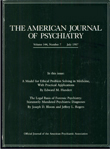Obsessive-compulsive disorder in the community: an epidemiologic survey with clinical reappraisal
Abstract
OBJECTIVE: To examine the prevalence of obsessive-compulsive symptoms and DSM-IV obsessive-compulsive disorder (OCD), the authors conducted a telephone survey of 2,261 adults in four regions of Canada. METHOD: Trained lay interviewers administered a modified version of the OCD section of the Comprehensive International Diagnostic Interview. A subsample of respondents with probable cases and probable subclinical cases of OCD was then blindly reinterviewed by research personnel experienced in the assessment of OCD, using the Structured Clinical Interview for DSM-IV and the Yale-Brown Obsessive Compulsive Scale, to confirm the diagnosis and gauge the severity of OCD. RESULTS: The weighted 1-month prevalence of OCD in the entire sample according to the lay interviews was 3.1%. Upon clinical reappraisal, the 1-month prevalence estimate of OCD dropped to 0.6%; an additional 0.6% had subclinical OCD. The mean Yale-Brown Obsessive Compulsive Scale score of the individuals with OCD was 19.0 (SD = 4.6, median = 21); for those with subclinical OCD, the mean score was 15.4 (SD = 2.4, median = 14). Common reasons for overdiagnosis of OCD by the lay interviewers were inappropriate labeling of worries or concerns as obsessions and overestimating the degree of interference or distress attributable to obsessive-compulsive symptoms. CONCLUSIONS: OCD, while hardly a rare condition, may be somewhat less prevalent than had been believed on the basis of previous surveys. Additional studies are needed to substantiate these findings and to delineate precisely the extent of disability and reduced quality of life attributable to OCD (and OCD variants) in the community.



